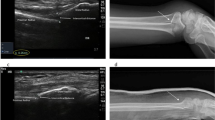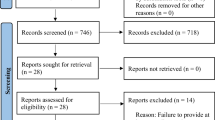Abstract
Purpose
Point-of-care ultrasound (POCUS) can be used to guide and assess reduction of pediatric forearm fractures. In this study, we sought to compare the success rate of ultrasound-guided fracture reduction with fluoroscopy-guided fracture reduction. We also sought to determine whether there are cost or time benefits to using ultrasound instead of fluoroscopy.
Methods
The electronic medical records of patients less than 18 years of age presenting to a pediatric emergency department with a forearm fracture between April 2016 and March 2019 were screened for inclusion in this study. A total of 27 ultrasound-guided reductions were identified during this time period and 81 fluoroscopy-guided reductions were randomly selected for comparison. Cost data was provided by the financial department. Reduction success, total length of stay, and costs were compared between the two groups, and multiple linear regression was used to determine the influence of any confounding predictor variables.
Results
There were no failed reductions in either group. Length of stay was shorter in the POCUS group (221 min) compared with the fluoroscopy group (254 min, p = 0.014), but this significance was lost in the regression model when adjusted for ketamine use. Provider costs ($430 v $442, p = 0.822) and total costs ($1219 v $1204, p = 0.851) were the same between the POCUS group and the fluoroscopy group, respectively.
Conclusion
POCUS appears to be an equally effective imaging modality to guide reduction of forearm fractures as compared to fluoroscopy.

Similar content being viewed by others
Data availability
The abstracted and analyzed data is available from the corresponding author upon reasonable request.
References
Price CTFJ (2006) Management of fractures. In: Lovell and Winter’s pediatric orthopaedics, 6th edn. LIppincott Williams & Wilkins, Philadelphia p. 1463
Nellans KW, Kowalski E, Chung KC (2012) The epidemiology of distal radius fractures. Hand Clin 28(2):113–125. https://doi.org/10.1016/j.hcl.2012.02.001
Wagner LK (2006) Minimizing radiation injury and neoplastic effects during pediatric fluoroscopy: what should we know? Pediatr Radiol 36(Suppl 2):141–145
Marin JR, Abo AM, Arroyo AC, Doniger SJ, Fischer JW, Rempell R, Gary B, Holmes JF, Kessler DO, Lam SHF, Levine MC, Levy JA, Murray A, Ng L, Noble VE, Ramirez-Schrempp D, Riley DC, Saul T, Shah V, Sivitz AB, Tay ET, Teng D, Chaudoin L, Tsung JW, Vieira RL, Vitberg YM, Lewiss RE (2016) Pediatric emergency medicine point-of-care ultrasound: summary of the evidence. Crit Ultrasound J 8(1):16
Chen L, Kim Y, Moore CL (2007) Diagnosis and guided reduction of forearm fractures in children using bedside ultrasound. Pediatr Emerg Care 23(8):528–531
Patel DD, Blumberg SM, Crain EF (2009) The utility of bedside ultrasonography in identifying fractures and guiding fracture reduction in children. Pediatr Emerg Care 25(4):5
Weinberg ER, Tunik MG, Tsung JW (2010) Accuracy of clinician-performed point-of-care ultrasound for the diagnosis of fractures in children and young adults. Injury. 41(8):862–868
Chaar-Alvarez FM, Warkentine F, Cross K, Herr S, Paul RI (2011) Bedside Ultrasound diagnosis of nonangulated distal forearm fractures in the pediatric emergency department. Pediatr Emerg Care 27(11):1027–1032
Barata I, Spencer R, Suppiah A, Raio C, Ward MF, Sama A (2012) Emergency ultrasound in the detection of pediatric long-bone fractures. Pediatr Emerg Care 28(11):1154–1157
Galletebeitia Laka I, Samson F, Gorostiza I, Gonzalez A, Gonzalez C (2017) The utility of clinical ultrasonography in identifying distal forearm fractures in the pediatric emergency department. Eur J Emerg Med 26(2):118–122
Wellsh BM, Kuzma JM (2016) Ultrasound-guided pediatric forearm fracture reductions in a resource-limited ED. Am J Emerg Med 34(1):40–44
Scheier E, Balla U (2017) Ultrasound-assisted reduction of displaced and shortened fractures by pediatric emergency physicians. Pediatr Emerg Care 33(9):654–656
Auten JD, Naheedy JH, Hurst ND, Pennock AT, Hollenbach KA, Kanegaye JT (2018) Comparison of pediatric post-reduction fluoroscopic- and ultrasound forearm fracture images. Am J Emerg Med 37(5):832–838
Chinnock B, Khaletskiy A, Kuo K, Hendey GW (2011) Ultrasound-guided reduction of distal radius fractures. J Emerg Med 40(3):308–312
Kodama N, Takemura Y, Ueba H, Imai S, Matsusue Y (2014) Ultrasound-assisted closed reduction of distal radius fractures. J Hand Surg Am 39(7):1287–1294
Van Schaik GWW, Van Schaik KD, Murphy MC (2019) Point-of-care ultrasonography (POCUS) in a community emergency department: an analysis of decision making and cost savings associated with POCUS. J Ultrasound Med 38(8):2133–2140
Tsou P, Chen KP, Wang Y et al (2019) Diagnostic Accuracy of Lung Ultrasound Performed by Novice Versus Advanced Sonographers for Pneumonia in Children: A Systematic Review and Meta-analysis. Acad Emerg Med 26(9):1074–1088
Berger T, Garrido F, Green J, Lema PC, Gupta J (2012) Bedside ultrasound performed by novices for the detection of abscess in ED patients with soft tissue infections. Am J Emerg Med 30(8):1569–1573
Parri N, Crosby BJ, Glass C, Mannelli F, Sforzi I, Schiavone R, Ban KM (2013) Ability of emergency ultrasonography to detect pediatric skull fractures: a prospective, observational study. J Emerg Med 44(1):135–141
Rabiner JE, Khine H, Avner JR, Friedman LM, Tsung JW (2013) Accuracy of point-of-care ultrasonography for diagnosis of elbow fractures in children. Ann Emerg Med 61(1):9–17
Hedelin H, Tingström C, Hebelka H, Karlsson J (2017) Minimal training sufficient to diagnose pediatric wrist fractures with ultrasound. Crit Ultrasound J 9(1):11
Acknowledgments
We would like to thank Timothy Lindsey, MBA, for his assistance with obtaining the cost data used in this study.
Author information
Authors and Affiliations
Contributions
MG conceptualized the study. JTG, MG, and MW designed the study. JTG performed all chart reviews and data abstraction. MW analyzed the data. JTG wrote the manuscript, which was critically revised by MG and MW. All authors read and approved the final manuscript.
Corresponding author
Ethics declarations
Conflict of Interest
The authors declare that they have no conflict of Interest.
Ethics approval and consent to participate
This study (2018-11-0102) received exempt status from the Institutional Review Board at the University of Texas at Austin.
Consent for publication
All authors give consent for publication.
Additional information
Publisher’s note
Springer Nature remains neutral with regard to jurisdictional claims in published maps and institutional affiliations.
Rights and permissions
About this article
Cite this article
Gillon, J.T., Gorn, M. & Wilkinson, M. Comparison of ultrasound-guided versus fluoroscopy-guided reduction of forearm fractures in children. Emerg Radiol 28, 303–307 (2021). https://doi.org/10.1007/s10140-020-01862-6
Received:
Accepted:
Published:
Issue Date:
DOI: https://doi.org/10.1007/s10140-020-01862-6




